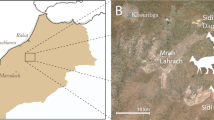Abstract
Neogene hominoid cranial material is regrettably scarce, especially from the middle and late Miocene. Between the 18-Myr-old virtually complete early Miocene Proconsul africanus skull from Rusinga1 and the 3–4-Myr-old Hadar hominoid cranial material2, the only significant large (non-hylobatid) hominoid facial or cranial specimens are those from the late Miocene Salonika in Greece3, Yassiören in Turkey4, Lufeng in China5, the possibly middle Miocene site of Moroto in Uganda6 and the new facial-mandibular piece from late Miocene deposits in Pakistan reported here. The specimen is a Sivapithecus indicus7 adult, probably male, and consists of most of the left side of the face including a small portion of the frontal bone, the zygomatic arch and temporo-mandibular joint, the maxilla, a virtually entire mandible and the complete dentition. The fossil, catalogued as GSP 15000, is the property of the Government of Pakistan and is at present on loan for study at Harvard University.
This is a preview of subscription content, access via your institution
Access options
Subscribe to this journal
Receive 51 print issues and online access
$199.00 per year
only $3.90 per issue
Buy this article
- Purchase on Springer Link
- Instant access to full article PDF
Prices may be subject to local taxes which are calculated during checkout
Similar content being viewed by others
References
Le Gros Clark, W. E. & Leakey, L. S. B. The Miocene Hominoidea of East Africa (British Museum (Natural History), London, 1951).
Johanson, D. C. & White, T. D. Science 202, 321 (1979).
de Bonis, L. & Melentis, J. Annls Paléont. 64, 185 (1978).
Andrews, P. & Tekkaya, I. Palaeontology 23, 85 (1980).
Qingwu, L., Xu, Q. & Zheng, L. Vert. PalAsiat. 19, 101 (1981).
Pilbeam, D. R. Bull. Peabody Mus. nat. Hist. 31 (1969).
Pilbeam, D. R., Rose, M. D., Badgley, C. & Lipschutz, B. Postilla 181 (1980).
Pilbeam, D. R., Behrensmeyer, A. K., Barry, J. C. & Shah, S. M. I. Postilla 179 (1979).
Barry, J. C., Behrensmeyer, A. K. & Monaghan, M. Postilla 183 (1980).
Badgley, C. & Behrensmeyer, A. K. Palaeogeogr. Palaeoclimat. Palaeoecol. 30, 133 (1980).
Tauxe, L. Nature 282, 399 (1979).
Lindsay, E. H., Johnson, N. M. & Opdyke, N. D. in Aspects of Vertebrate History: Essays in Honor of Edwin Harris Colbert (ed. Jacobs, L. L.) (Museum of Northern Arizona Press, 1980).
Behrensmeyer, A. K. & Tauxe, L. Sedimentology (in the press).
Barry, J. C., Lindsay, E. H. & Jabocs, L. L. Palaeogeogr. Palaeoclimat. Palaeoecol. (in the press).
Pilbeam, D. R. & Smith, R. Geol. Surv. Pakistan Mem. (in the press).
Whybrow, P. J. & Andrews, P. Folia Primatol. 30, 115 (1978).
Corruccini, R. S. & Henderson, A. M. Primates 19, 35 (1978).
Author information
Authors and Affiliations
Rights and permissions
About this article
Cite this article
Pilbeam, D. New hominoid skull material from the Miocene of Pakistan. Nature 295, 232–234 (1982). https://doi.org/10.1038/295232a0
Received:
Accepted:
Issue Date:
DOI: https://doi.org/10.1038/295232a0
This article is cited by
-
The first hominoid from the Maragheh Formation, Iran
Palaeobiodiversity and Palaeoenvironments (2016)
-
A new orang-utan relative from the Late Miocene of Thailand
Nature (2004)
-
A Middle Miocene hominoid from Thailand and orangutan origins
Nature (2003)
Comments
By submitting a comment you agree to abide by our Terms and Community Guidelines. If you find something abusive or that does not comply with our terms or guidelines please flag it as inappropriate.



